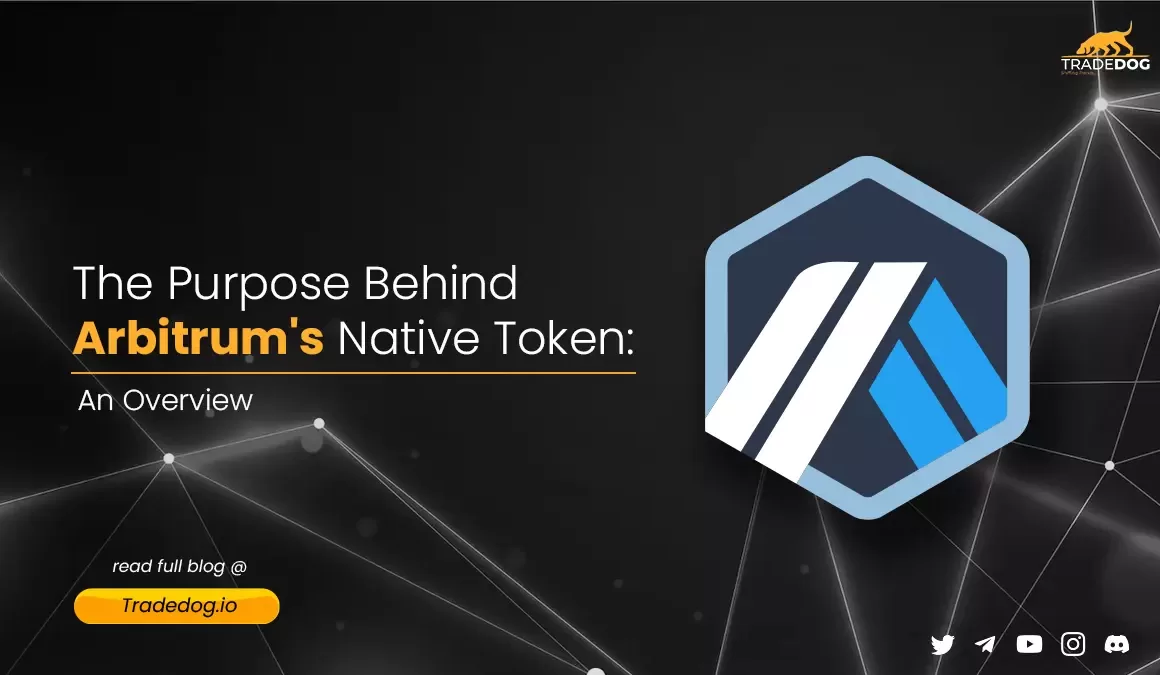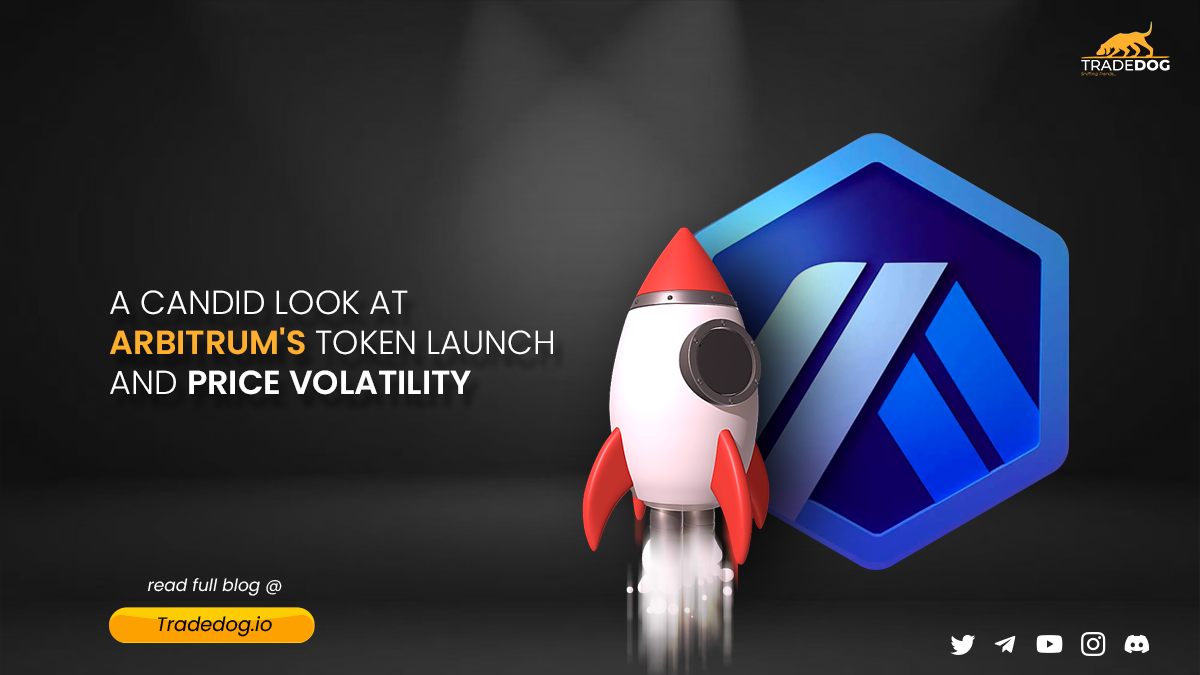Quick Links
What is Arbitrum?
Arbitrum is a Layer 2 scaling solution for Ethereum that has been gaining popularity in the blockchain community due to its ability to increase the speed and efficiency of the network while reducing transaction costs. If you are unfamiliar with layer 2 solutions, check out the blog by TradeDog.
With almost $6.9 Bn total value locked in Ethereum, 86% of the market share is captured by 2 L2 solutions, i.e., Arbitrum and Optimism. Arbitrum One is the current industry leader with a total value locked (TVL) of $3.85 billion, giving it a dominant 55.97% market share. Optimism is second with $2.04 billion TVL and a 29.67% share of the L2 market.
Listed below are some of the pros and cons of L2 scaling solution competitors
Pros
| Polygon | Arbitrum | Optimism |
| Secure due to the validation system | It offers 100 times the throughput with only 2% of the fees | EVM equivalence focuses on going one-step ahead |
| Uses a joint system of PoS & Hemidall architecture which increases the scalability & power | As it is completely decentralized, the KYC requirement is eliminated | High secured data |
| The multi-chain system allows Polygon to access & use the full power of Ethereum | A good ecosystem with powerful tools | Faster transactions with low costs |
| Polygon offers a similar experience to that of Ethereum | High EVM compatibility |
Cons
| Polygon | Arbitrum | Optimism |
| If Ethereum 2.0 is developed completely, Polygon’s existence may be challenged in the coming days | Does not have any native token (Yet) | Long & costly withdrawals |
| It is Ethereum dependant | The Arbitrum gas fees are different from the Ethereum gas fees, serving a different purpose | Potential incentive misalignment between network participants |
| High competition among the other scaling networks like Polkadot, Solana, etc | Underlying L1 censoring transactions |
After closely examining the potential of all the participants, it is pretty clear that even though Arbitrum is considered the king of L2 with more than 200 Dapps and $2.55 Bn TVL, according to the data from DeFillama, one of the cons in the ecosystem was the absence of its native token.
Addressing this issue, the team behind Arbitrum has announced the launch of its native token. This blog will delve into the details of the upcoming Arbitrum token launch, including the token’s purpose, distribution, upcoming airdrop, and potential future developments.
Why Arbitrum is launching its native token?
The Arbitrum Foundation has introduced a new token, $ARB, signalling its transformation into a decentralized autonomous organization (DAO). Offchain Labs was the only organization in charge of modifying or adjusting the scaling technology until now.
Goldfeder (CEO – Offchain Labs) and his group will transfer these restrictions to its community in conjunction with the token launch. The code will also be modified concurrently with each vote the DAO conducts. DAO votes are often used to tell developer teams what modifications to make. However, examples from the past also demonstrate that this signal may only sometimes be carried out on-chain. According to an article by decrypt, the founder emphasized the purpose of establishing a DAO by stating, “The community will have the ability to decide the future of technology and how it wants to license it,”
Moreover, the Arbitrum foundation believes that the launch, which transfers ownership of the chain and responsibility for fostering and expanding the Arbitrum ecosystem to The Arbitrum Foundation and DAO, is the next step towards decentralization as a result of the technology’s maturation and broader validation as a few months ago, it was revealed that ten independent institutional validators have signed up to validate Arbitrum One. Moreover, Arbitrum One was upgraded to Nitro in August as well.
Potential Utilities of $ARB token
For now, we only know that the native token of Arbitrum will be used only as a governance token which the community will hold to decide future updates and developments on the Arbitrum network. However, we at TradeDog believe that the token might have some future utilities considering the history, which might include –
- Burning ARB tokens.
- Lock-up periods for running a DEX on Arbitrum.
- DEX operator staking to reduce fees on the platform.
- Project funding on Arbitrum.
- Participating in project management with the Arbitrum community
Token Airdrop and Launch details
Arbitrum One and Arbitrum Nova’s major decisions will be put to a vote by ARB holders. On March 23, 2023, the community will be given an airdrop of ARB tokens, with a total quantity of 10 billion. 56% of the tokens will be owned by the community, while the remaining 44% will belong to Offchain Labs, the software company that developed Arbitrum, as well as to its investors and staff. 11.62% of ARB tokens will be airdropped and according to the tweet by Nansen, 625,143 wallet addresses are eligible for the same.
There are six airdrop criteria, and at least three must be met in order to qualify for the airdrop:
- Bridged to Arbitrum One or Arbitrum Nova
- Conducted transactions at least two months before the snapshot on February
- Conducted at least 4 transactions or interacted with at least 4 smart contracts
- Conducted transactions with at least $10,000 in aggregate value
- Deposited at least $10,000 on Arbitrum One
- Conducted at least 3 transactions on Arbitrum Nova.
In order to check your eligibility, you need to –
- Visit the Arbitrum airdrop page.
- Connect your wallet.
- Now click on “Check Eligibility”.
- If you’re eligible then you will see the number of tokens you will get when the claim goes live on 23rd March 2023.
To trade the token, Bybit has announced that $ARB will be available for trading starting from March 23, 2023, with trading pairs including Spot*: ARB/USDT, ARB/USDC, and Derivatives: ARBUSDT. ARB deposit opening time is yet to be confirmed, but withdrawals will be available starting from March 24, 2023. Bybit is offering a special promotion where each deposit of 250 ARB makes traders eligible to earn 25 USDT.
Trends of launching native tokens among L2
Although, the L2 scaling solution has been in the game for quite some time, I believe it is yet to show its potential, as very recently the effect of Coinbase launching its L2 solution saw an upsurge in Optimism by 16% clearly indicating the positive outlook surrounding this solution even in these bear markets. With the popularity, we also saw the competitors including optimism, Loopring, and Avalanche getting into the game by launching their native token.
Optimism’s native token also called optimism (OP), helps fund third-party development proposals and integrations on the Optimism platform, via the Optimism Collective decentralised autonomous organisation (DAO). People who hold OP can also take part in votes on the future of the network. OP had a value of $4.57 on May 31, 2022, when it entered the open market via the first airdrop. Yet, it appears that pricing was overly optimistic. As soon as the market realised it was overpriced, it sent it down to a low of $0.7973 before completing the day at $1.44, which was 68.5% below the starting price. The token saw a lot of movements during that time as various events like the Terra Luna collapse took place followed by the ETH merge and then the FTX collapse. Since then the token has seen decent growth with the surge mainly happening due to the project’s development. The token is valued at $2.46 at the time of writing with the market cap of $72 Mn and can be seen on majour exchanges including Binance, Coinbase exchange and MEXC Global.
Loopring’s LRC token can be staked by anyone to earn part of 70% of the protocol fees of all exchanges built on top of Loopring. (20% funds the Loopring DAO and the remaining 10% is burned). Additionally, an exchange owner needs to stake LRC for economic security & reputation while it can be also staked to lower the protocol fees on a specific exchange by an exchange owner, market makers, and high-frequency traders. Similarly, Avalanche’s AVAX token is used to pay for transaction and gas fees, interact with smart contracts and take advantage of Avalanche’s staking rewards.
Hence, it was observed that plenty of L2 solutions have previously launched their native tokens with different utility on-chain, and the price of the tokens was majorly affected by the market sentiments. However, being the torch bearer of L2 chains, Arbitrums $ARB is expected to see immense popularity on launch and I personally am very bullish for the native token as the markets are also improving.
Conclusion
The upcoming Arbitrum token airdrop event on March 23rd is expected to be a major milestone for the platform, and investors are eagerly anticipating the launch as the native token holders will be having governance rights over the platform.
As a market leader in the Layer 2 space, Arbitrum has the potential to see tremendous growth in the coming years. With the growing demand for scalable and efficient infrastructure for decentralized applications, the need for solutions like Arbitrum will only continue to increase. This presents a significant opportunity for the platform and its investors.
Overall, the launch of Arbitrum’s native token represents a significant milestone for the platform, and its potential utility and growth make it an exciting prospect for investors and developers alike. As the ecosystem continues to evolve, it will be interesting to see how Arbitrum and other Layer 2 solutions shape the future of decentralized applications.










